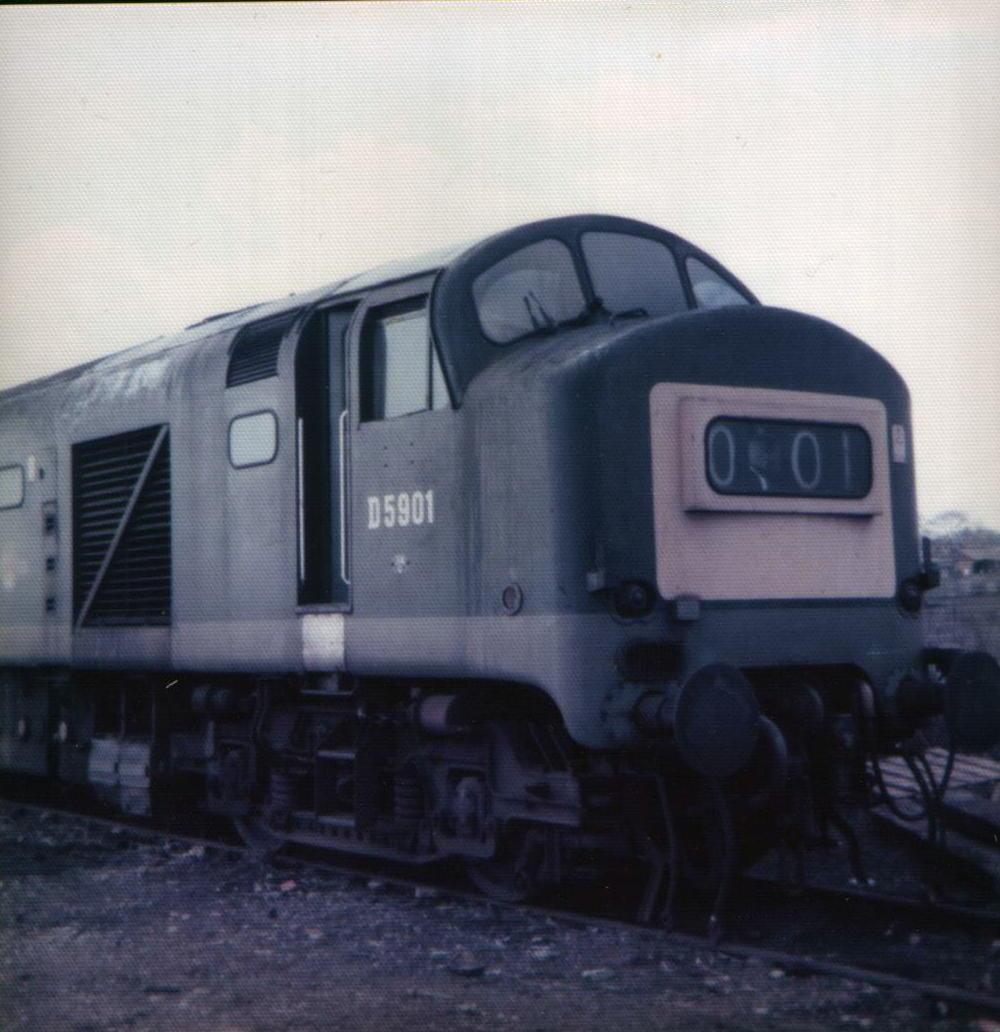- British Rail Class 23
Infobox Locomotive
name = English Electric Type 2
British Rail Class 23
powertype = Diesel-electric

caption = “Baby Deltic” D5901 with the revised cab front.
roadnumber = D5900–D5909
totalproduction = 10
nicknames = "Baby Deltic"
builder =English Electric atVulcan Foundry
builddate = 1959
gauge = RailGauge|ussg|lk=on|al=on
primemover = Napier T9-29 Deltic
tractionmotors =
transmission = DC generator, DC traction motors
whytetype = Bo-Bo
uicclass = Bo'Bo'
wheeldiameter = convert|3|ft|7|in|m|3|abbr=on
minimumcurve = convert|4|chain|m|lk=in
trainbrakes = Vacuum
locobrakeforce =
wheelbase = convert|40|ft|6|in|m|2|abbr=on
length = convert|52|ft|6|in|m|2|abbr=on
width = convert|8|ft|10+3/4|in|m|2|abbr=on
height = convert|12|ft|8|in|m|2|abbr=on
weight = convert|74|LT|sigfig=3|lk=on
topspeed = convert|75|mph|km/h|0|abbr=on|lk=on
poweroutput = "Engine:" convert|1100|hp|abbr=on|sigfig=3|lk=on
tractiveeffort = "Maximum:" convert|47000|lbf|kN|1|abbr=on
fuelc
convert|550|impgal|lk=on|abbr=on
trainheating = Steam
multipleworking = ★ Blue star
axleloadclass =Route availability
railroad =British Railways
retiredate = TheBritish Rail Class 23 Bo-BoDiesel-electric locomotive s (so-called 'Baby Deltics') were a ten strong class oflocomotives built by the English Electric Company in 1959. They were numbered from D5900 to D5909. The power unit used aNapier Deltic T9-29 9 cylinder engine of 1100 hp driving an EE generator, which powered the four traction motors.Usage
After acceptance trials at
Doncaster , the locos were based atHornsey , although at weekends were usually located at Hitchin engine shed. It had been BR's original intention to work the locos acrossLondon on the widened lines but they were found to be too heavy. The first of the class was stopped atVulcan Foundry whilst EE tried to reduce the weight but this could not be completed to a satisfactory standard.The locomotives were put to work on King's Cross outer suburban duties such as the Cambridge Buffet Express as well as services from Kings Cross to Moorgate. The locomotives were later banned from Moorgate because of excessive exhaust smoke in the tunnels.
Problems
It wasn't long before serious problems were being found with the class. Many engines seized because the shaft driving the auxiliaries from the engine snapped and whipped round rupturing coolant hoses {The Deltic Locomotives Of British Rail, by Brian Webb}. Other lubrication problems caused seized pistons and cracked cylinder liners. By around 1963, all the locomotives had gradually been moved to Stratford Depot as they failed and were added to the line in store, pending a decision on their future. By this time the locos were based at the new diesel maintenance depot at Finsbury Park.
Modification
It was decided by BR and EE to carry out a program to refurbish the class and modify the engines with new parts designed by the engine manufacturer. The locos also had modifications to their nose ends, losing the gangway doors and headcode discs in favour of a central roller blind headcode box. The livery also changed to two tone green with grey roof similar to that of their larger sisters so they looked every bit a 'baby deltic'. The locomotives gradually returned to traffic and became very reliable in traffic except for ongoing coolant system problems.
Withdrawal
By the late 1960s, BR had drawn up a "National Traction Plan", whose aim was to rationalise the number and types of diesel locomotives in traffic (and thus reduce operating costs). The 'Baby Deltics' were an obvious target, being only a ten-strong class, and still beset with ongoing operational problems. The locos were withdrawn between 1968 and 1971. The last two locos in traffic on revenue-earning service were D5905 and D5909. Several of the class received full yellow ends whilst still in two-tone green; a couple even carried the new double-arrow BR symbol. D5909 was the only locomotive to receive the full "rail blue" livery. D5901 was transferred to the departmental fleet of the
Railway Technical Centre in 1969. It worked test trains to and from the RTC until 1975, when it was replaced by a Class 24. The loco was cut up in 1977, still carrying two-tone green livery with a grey roof and small yellow warning panel.Preservation
Possibly the only part of a Baby Deltic to survive (apart from works plates) is the T9-29 engine from the last Baby Deltic to be cut up. It is at the Deltic Preservation Society in Chesterfield, and is presently undergoing a restoration to fully operational condition by three private individuals.
Sources
*cite book | last = Stevens-Stratten | first = S.W. | coauthors = Carter, R.S. | title = British Rail Main-Line Diesels | publisher = Ian Allen Ltd | date= 1978 | location = Shepperton | isbn = 0 7110 0617 2
*Ian Allan ABC of British Railways Locomotives, summer 1966 editionModels
The Class 23 "Baby Deltic" has been made as a kit from Silver Fox models but has yet to be made as a ready to run 00 gauge model. Between 1960 and 1965 the Class 23 was available in 000 (approximately N) gauge as part of the Lone Star "Treble-O-Lectric" range of diecast models in both powered and unpowered versions.
External links
* [http://www.silverfoxmodels.co.uk/ Silver Fox models]
* [http://www.therailwaycentre.com/Pages%20Loco/Recognition%20loco/Illus_23.html Class 23 infomation]
* [http://www.thedps.co.uk/gallery/babydeltic The Deltic Preservation Society] Contains photos of the restoration of the engine
Wikimedia Foundation. 2010.
